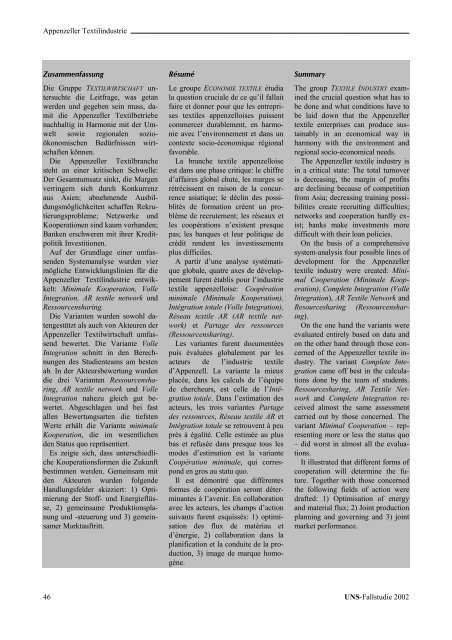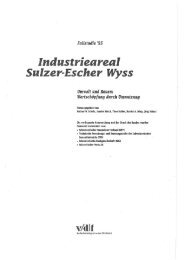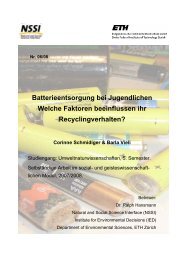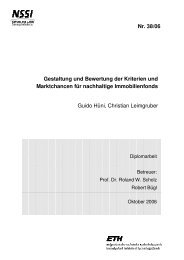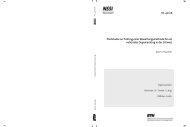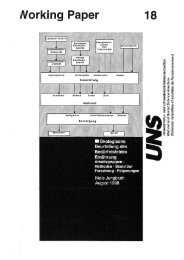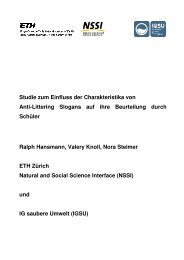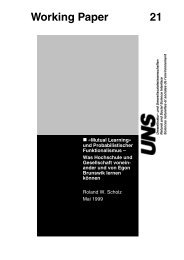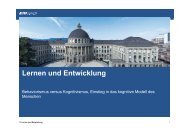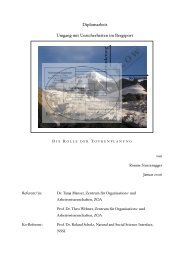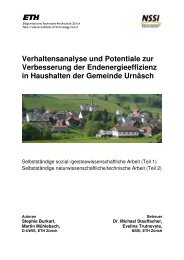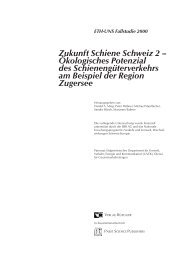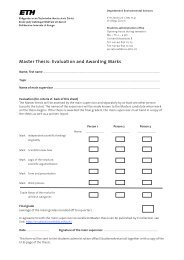Appenzell Ausserrhoden - ETH Zurich - Natural and Social Science ...
Appenzell Ausserrhoden - ETH Zurich - Natural and Social Science ...
Appenzell Ausserrhoden - ETH Zurich - Natural and Social Science ...
Sie wollen auch ein ePaper? Erhöhen Sie die Reichweite Ihrer Titel.
YUMPU macht aus Druck-PDFs automatisch weboptimierte ePaper, die Google liebt.
<strong>Appenzell</strong>er Textilindustrie<br />
Zusammenfassung<br />
Die Gruppe TEXTILWIRTSCHAFT untersuchte<br />
die Leitfrage, was getan<br />
werden und gegeben sein muss, damit<br />
die <strong>Appenzell</strong>er Textilbetriebe<br />
nachhaltig in Harmonie mit der Umwelt<br />
sowie regionalen sozioökonomischen<br />
Bedürfnissen wirtschaften<br />
können.<br />
Die <strong>Appenzell</strong>er Textilbranche<br />
steht an einer kritischen Schwelle:<br />
Der Gesamtumsatz sinkt, die Margen<br />
verringern sich durch Konkurrenz<br />
aus Asien; abnehmende Ausbildungsmöglichkeiten<br />
schaffen Rekrutierungsprobleme;<br />
Netzwerke und<br />
Kooperationen sind kaum vorh<strong>and</strong>en;<br />
Banken erschweren mit ihrer Kreditpolitik<br />
Investitionen.<br />
Auf der Grundlage einer umfassenden<br />
Systemanalyse wurden vier<br />
mögliche Entwicklungslinien für die<br />
<strong>Appenzell</strong>er Textilindustrie entwikkelt:<br />
Minimale Kooperation, Volle<br />
Integration, AR textile network und<br />
Ressourcensharing.<br />
Die Varianten wurden sowohl datengestützt<br />
als auch von Akteuren der<br />
<strong>Appenzell</strong>er Textilwirtschaft umfassend<br />
bewertet. Die Variante Volle<br />
Integration schnitt in den Berechnungen<br />
des Studienteams am besten<br />
ab. In der Akteursbewertung wurden<br />
die drei Varianten Ressourcensharing,<br />
AR textile network und Volle<br />
Integration nahezu gleich gut bewertet.<br />
Abgeschlagen und bei fast<br />
allen Bewertungsarten die tiefsten<br />
Werte erhält die Variante minimale<br />
Kooperation, die im wesentlichen<br />
den Status quo repräsentiert.<br />
Es zeigte sich, dass unterschiedliche<br />
Kooperationsformen die Zukunft<br />
bestimmen werden. Gemeinsam mit<br />
den Akteuren wurden folgende<br />
H<strong>and</strong>lungsfelder skizziert: 1) Optimierung<br />
der Stoff- und Energieflüsse,<br />
2) gemeinsame Produktionsplanung<br />
und -steuerung und 3) gemeinsamer<br />
Marktauftritt.<br />
Résumé<br />
Le groupe ECONOMIE TEXTILE étudia<br />
la question cruciale de ce qu’il fallait<br />
faire et donner pour que les entreprises<br />
textiles appenzelloises puissent<br />
commercer durablement, en harmonie<br />
avec l’environnement et dans un<br />
contexte socio-économique régional<br />
favorable.<br />
La branche textile appenzelloise<br />
est dans une phase critique: le chiffre<br />
d’affaires global chute, les marges se<br />
rétrécissent en raison de la concurrence<br />
asiatique; le déclin des possiblités<br />
de formation créent un problème<br />
de recrutement; les réseaux et<br />
les coopérations n’existent presque<br />
pas; les banques et leur politique de<br />
crédit rendent les investissements<br />
plus difficiles.<br />
A partir d’une analyse systématique<br />
globale, quatre axes de développement<br />
furent établis pour l’industrie<br />
textile appenzelloise: Coopération<br />
minimale (Minimale Kooperation),<br />
Intégration totale (Volle Integration),<br />
Réseau textile AR (AR textile network)<br />
et Partage des ressources<br />
(Ressourcensharing).<br />
Les variantes furent documentées<br />
puis évaluées globalement par les<br />
acteurs de l’industrie textile<br />
d’<strong>Appenzell</strong>. La variante la mieux<br />
placée, dans les calculs de l’équipe<br />
de chercheurs, est celle de l’Intégration<br />
totale. Dans l’estimation des<br />
acteurs, les trois variantes Partage<br />
des ressources, Réseau textile AR et<br />
Intégration totale se retrouvent à peu<br />
près à égalité. Celle estimée au plus<br />
bas et refusée dans presque tous les<br />
modes d’estimation est la variante<br />
Coopération minimale, qui correspond<br />
en gros au statu quo.<br />
Il est démontré que différentes<br />
formes de coopération seront déterminantes<br />
à l’avenir. En collaboration<br />
avec les acteurs, les champs d’action<br />
suivants furent esquissés: 1) optimisation<br />
des flux de matériau et<br />
d’énergie, 2) collaboration dans la<br />
planification et la conduite de la production,<br />
3) image de marque homogène.<br />
Summary<br />
The group TEXTILE INDUSTRY examined<br />
the crucial question what has to<br />
be done <strong>and</strong> what conditions have to<br />
be laid down that the <strong>Appenzell</strong>er<br />
textile enterprises can produce sustainably<br />
in an economical way in<br />
harmony with the environment <strong>and</strong><br />
regional socio-economical needs.<br />
The <strong>Appenzell</strong>er textile industry is<br />
in a critical state: The total turnover<br />
is decreasing, the margin of profits<br />
are declining because of competition<br />
from Asia; decreasing training possibilities<br />
create recruiting difficulties;<br />
networks <strong>and</strong> cooperation hardly exist;<br />
banks make investments more<br />
difficult with their loan policies.<br />
On the basis of a comprehensive<br />
system-analysis four possible lines of<br />
development for the <strong>Appenzell</strong>er<br />
textile industry were created: Minimal<br />
Cooperation (Minimale Kooperation),<br />
Complete Integration (Volle<br />
Integration), AR Textile Network <strong>and</strong><br />
Resourcesharing (Ressourcensharing).<br />
On the one h<strong>and</strong> the variants were<br />
evaluated entirely based on data <strong>and</strong><br />
on the other h<strong>and</strong> through those concerned<br />
of the <strong>Appenzell</strong>er textile industry.<br />
The variant Complete Integration<br />
came off best in the calculations<br />
done by the team of students.<br />
Ressourcesharing, AR Textile Network<br />
<strong>and</strong> Complete Integration received<br />
almost the same assessment<br />
carried out by those concerned. The<br />
variant Minimal Cooperation – representing<br />
more or less the status quo<br />
– did worst in almost all the evaluations.<br />
It illustrated that different forms of<br />
cooperation will determine the future.<br />
Together with those concerned<br />
the following fields of action were<br />
drafted: 1) Optimisation of energy<br />
<strong>and</strong> material flux; 2) Joint production<br />
planning <strong>and</strong> governing <strong>and</strong> 3) joint<br />
market performance.<br />
46 UNS-Fallstudie 2002


